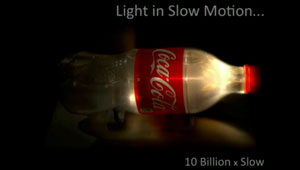The megapixels war is long dead, long live the next dimension in imaging: femto-photography, an imaging technology so fast that a slow motion video can show light in motion. The future of this? They’ll reate cameras that can look around corners beyond the line of sight or cameras that see inside the body without X-rays.

For the fun of it, let’s say you got a femto movie of a second. One second. Now let’s assume you format it into a common normal 24 fps movie. How long will it take to watch the whole movie? It’s gonna be a pretty boring film — lasting for a 1,320 years altogether.
More on fempto-photography from Wikipedia:
Femto-photography is a term describing ultra high speed imaging. Femto-photography of macroscopic objects was first done by a team at the MIT Media Lab lead by Raskar. Before that the term has at least been used for certain proposed experimental procedures in experimental nuclear physics.
In their publications Raskar’s team claims to be able to capture exposures so short that light only traverses 0.6mm (equal to only a few picoseconds, or thousands of femtoseconds) during one exposure by combining available high-end research equipment and sophisticated sampling algorithms. Raskar presented his team’s feat during TEDGlobal 2012, reaching a wider audience through viral video.
In his demonstration, he shows a 1mm wide light “bullet,” created by flashing a laser for one trillionth of a second, passing through a bottle in darkness. As the beam of light hits the other end of the bottle, the photons disperse and ripple through the entire body before exploding upon contact with the cap. The whole phenomenon takes place in less than a nanosecond.
The femto-photography technique allowed Raskar’s team to, among other things, show the path of a packet of light traversing a coca cola bottle and to image an object hidden behind a corner by reconstruction of individual photon reflection paths.
The future? Camera reviews dwelling on 1,000,000,000,000 fps and filming at places you’re actually not. Now that’s gonna be fun. Ultimate big brother becoming reality.


